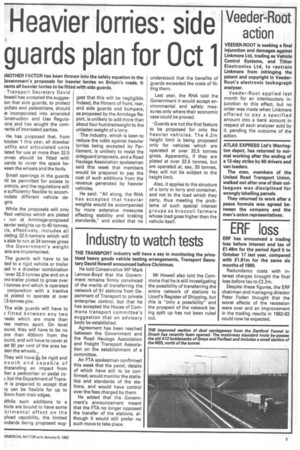Heavier lorries: side guards plan for Oct 1
Page 3

If you've noticed an error in this article please click here to report it so we can fix it.
INOTHER FACTOR has been thrown into the safety equation in the ;overnment's proposals for heavier lorries on Britain's roads. It rants all heavier lorries to be fitted with side guards.
Transport Secretary David lowell has accepted the suggesion that side guards, to protect yclists and pedestrians, should e incorporated into amended :onstruction and Use Regulaions and has sought the cornrents of interested parties.
He has proposed that, from )ctober 1 this year, all drawbar utfits and articulated units lated for use at more than 32.5 )nnes should be fitted with uards to cover the space beween the wheels and the body.
Small openings in the guards fill be permitted for access to ontrols, and the regulations will e sufficiently flexible to accomiodate different vehicle degns.
While the proposals will only ffect vehicles which are plated ) run at Armitage-proposed eavier weights up to 40 tonnes, lis, effectively, includes all Kisting 32.5-tonners which will e able to run at 34 tonnes gross the Government's weight 'ans are implemented.
The guards will have to be led to a rigid vehicle or trailer ;ed in a drawbar combination over 32.5 tonnes gtw and on a :mi-trailer plated to gross over i tonnes and which is operated conjunction with a tractive -lit plated to operate at over !.5 tonnes gtw.
The side guards will have to fitted between any two heels which are more than ree metres apart. On level ound, they will have to be no ore than 400mm from the ound, and will have to cover at 3st 90 per cent of the area beeen the wheels..
They will have 0 be rigid and nooth and capable of thstanding an impact from her a pedestrian or pedal cy), but the Department of Transft is prepared to accept that ey can be flexible for up to Omm from their edges.
While such additions to a hide are bound to have some :trimental effect on the yload capability, the limited mdards being proposed sug gest that this will be negligible. Indeed, the fitment of front, rear, and side guards and bumpers, as proposed by the Armitage Report, is unlikely to add more than about four hundredweight to the unladen weight of a lorry.
The industry, which is keen to reduce the odds against heavier lorries being accepted by Parliament, is unlikely to resist the sideguard proposals, and a Road Haulage Association spokesman said this week that members would be prepared to pay the cost of such additions from the revenue generated by heavier vehicles.
He said: "All along, the RHA has accepted that heavier weights would be accompanied by more extensive measures affecting stability and braking standards," and added that he understood that the benefits of guards exceeded the costs of fitting them.
Last year, the RHA told the Government it would accept environmental and safety measures only where their economic case could be proved.
Guards are not the first feature to be proposed for only the heavier vehicles. The 4.2m height limit is being proposed only for vehicles which are operated at over 32.5 tonnes gross. Apparently, if they are plated at over 32.5 tonnes, but are operated at, say, 30 tonnes, they will not be subject to the height limit.
Also, it applies to the structure of a lorry or lorry and container, and not to the load which they carry, thus meeting the problems of such special interest groups as broccoli farmers whose load goes higher than the vehicle itself.










































